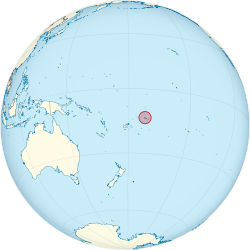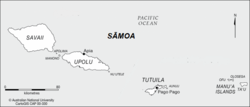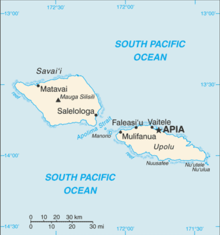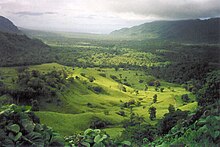
Upolu is an island in Samoa, formed by a massive basaltic shield volcano which rises from the seafloor of the western Pacific Ocean. The island is 75 kilometres long and 1,125 square kilometres in area, making it the second largest of the Samoan Islands by area. With approximately 145,000 inhabitants, it is by far the most populous of the Samoan Islands. Upolu is situated to the southeast of Savai'i, the "big island". Apia, the capital, is in the middle of the north coast, and Faleolo International Airport is at the western end of the island. The island has not had any historically recorded eruptions, although there is evidence of three lava flows, dating back only to between a few hundred and a few thousand years ago.

Faleolo International Airport is an airport located 40 kilometres (25 mi) west of Apia, the capital of Samoa. Until 1984, Faleolo could not accommodate jets larger than a Boeing 737. Services to the United States, Australia, or New Zealand, could only land at Pago Pago International Airport in American Samoa. Since the airport's expansion most international traffic now uses Faleolo.

United States Naval Station Tutuila was a naval station in Pago Pago Harbor on the island of Tutuila, part of American Samoa, built in 1899 and in operation until 1951. During the United States Navy rule of American Samoa, from 1900 to 1951, it was customary for the commandant of the station to also serve as Military Governor of the territory. Benjamin Franklin Tilley was the first commandant and the first officer responsible for the naval station's construction.
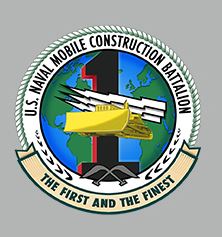
Naval Mobile Construction Battalion 1, is a United States Navy Seabee battalion. NMCB ONE, the original "Pioneers", has a long, proud and distinguished history as the very first Naval Construction Battalion of the service that would become known as the Seabees.

Naval Mobile Construction Battalion 11 is a United States Navy Construction Battalion, otherwise known as a Seabee Battalion, presently home-ported at the Naval Construction Battalion Center. The unit was formed during World War II as the 11th Naval Construction Battalion at Camp Allen on 28 June 1942. On 1 July, she moved to the new Seabee base Camp Bradford. Seabee battalions were numbered sequentially in the order they were stood up. The battalion lost one man during the war to a construction accident. The 11th CB was inactivated on 1 December 1945, at Subic Bay, Philippines.

US Naval Advance Bases were built globally by the United States Navy during World War II to support and project U.S. naval operations worldwide. A few were built on Allied soil, but most were captured enemy facilities or completely new. Advance bases provided the fleet with support to keep ships tactically available with repair and supply depots of facilities, rather than return them to the continental United States. Before Japan declared war on the United States the U.S. Navy had a single fleet-sized advanced base in the Territory of Hawaii at Naval Station Pearl Harbor. During the war the U.S. Navy Seabees built over 400 advance bases categorized by size. Naval bases were either Lions or Cubs while airfields were either Oaks or Acorns. Lions and Oaks were major facilities while Cubs and Acorns were minor. PT Boats typically would get a Cub and airfields with single runways were Acorns. The larger bases could do refueling and overhaul; loading of troopship and cargo ships; and preparing amphibious assault ships. Some became major repair depots. The Seabees developed auxiliary floating drydocks were able to repair battle damage and do regular maintenance in the field saving ships trans-pacific trips for repair. A few bases also were developed to be R and R for all U.S. personnel. Most Advance Bases were built by the US Navy's Seabees in Naval Construction Battalions (CBs). At the start of the war civilian contractors were employed in construction. The Seabees in World War II built most of the airfields used by the United States Army Air Forces and United States Marine Corps, as they had the ships and cranes needed to transport the vast amount of equipment needed at the advance bases. The US Army and United States Coast Guard also operated out of many of these facilities. Seabees could build new or repair damaged runways, and with advancements in heavy bomber technology lengthen runways as needed. A few Naval Advance Bases were built for the Korean War and Vietnam War.

Naval Base Saipan or Naval Advance Base Saipan or Naval Air Base Saipan was a United States Navy Naval base built during World War II to support Pacific Ocean theater of war and the many warships and troops fighting the war. The base was on the island of Saipan in the Northern Mariana Islands. The base was part of the Pacific island hopping campaign. The base construction started after the Battle of Saipan ended on July 9, 1944. US Naval Advance Base Saipan was constructed by the Seabees Naval Mobile Construction Battalions. The base was under the Commander Naval Forces Marianas. Saipan is 12 miles (19 km) long and 5 miles (8.0 km) wide. About 70% of the island was sugarcane cultivation at the start of the base construction. At the start of the Battle of Saipan, the island's population had about 30,000 Japanese troops and about 20,000 Japanese civilians. The city of Garapan was the administrative center for the Saipan governmental district.

Naval Base Noumea was a major United States Navy sea and air base at Nouméa, New Caledonia. Naval Base Noumea was built at Noumea Harbor. Noumea was picked for a Naval Base as it was beyond the range of Japanese land-based planes. Noumea is on the east side the Coral Sea, 1,469 km, from Brisbane, Australia. The Base was built during World War II to support the many ships and aircraft fighting and patrolling in the South West Pacific theatre of war as part of the Pacific War. Naval Base Noumea had anchorage for large ships. Noumea was protected against submarine attack by ring of islands and Naval minefields. At its peak 50,000 Troops were stationed at Naval Base Noumea. New Caledonia has been a colony of France since 1853. Noumea is the capital City of New Caledonia on the southwest end of the island. On November 8, 1942, US Navy South Pacific headquarter moved to Noumea.

Manus Naval Base was a number of bases built after the World War II Battle of Manus by United States Navy on the Manus Island and a smaller island just east, Los Negros Island in the Admiralty Islands chain. The major naval base construction started with the Los Negros landings on February 28, 1944. The Navy repaired and did the expansion of the airfields on the Admiralty Islands. United States Navy Seabee built or repaired the facilities on the islands. The large Manus Naval Base, also called the Admiralty Island base, supported United States Seventh Fleet, Southwest Pacific command, and part of the Pacific Fleet. The base was abandoned by the US Navy after the war.

Naval Base Brisbane was a major United States Navy base built in the early part of World War II at Brisbane, Queensland, Australia. At first, operated as a base for patrol aircraft and convoy escort aircraft to protect the last leg of the Pacific War to the Southwest Pacific. As the US Navy expanded in the island hopping campaign, Naval Base Brisbane expanded to include a submarine base, repair depot, seaplane base and other facilities. US Navy operations started on April 14, 1942, and ended after the war in 1945.
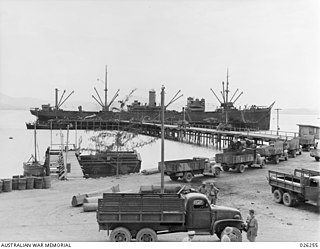
Naval Base Port Moresby was a United States Navy base built during World War II at the city of Port Moresby on Papua New Guinea. The US Navy built a communication center and advance base headquarters for the US Seventh Fleet to support the Pacific War in 1943. The base was part of the New Guinea campaign.

Naval Base Woodlark Island was a United States Navy base built during World War II on Woodlark Island on Papua New Guinea. The US Navy built a PT boat base, boat repair depot, and harbor facilities at the city of Guasopa to support the Pacific War in 1943. The Harbor facilities was also built to support the US Navy in building the Narewa Airfield on the island. The base was part of the New Guinea campaign.

Naval Base Banika Island was a United States Navy base built during World War II on Mbanika Island in the Russell Islands, part of the Solomon Islands. A larger supply depot was built to support the ships fighting in the Pacific War. Also built were a repair base for landing craft, PT boats, and other boats. Banika Island offered excellent fleet anchorage. Banika Island was taken during the Solomon Islands campaign. Also at the base was built the Renard Sound Seaplane Base.

Naval Base Puerto Princesa, Naval Base Palawan, was a United States Navy base built during World War II at Puerto Princesa on Palawan Island, Philippines, after the Invasion of Palawan on February 28, 1945. Puerto Princesa Bay offered an excellent base for fleet anchorage. At the naval base, US Navy Seabees built: a seaplane base, carrier aircraft fighter plane repair depot, land airfield and other base facilities.

Naval Base Funafuti was a naval base built by the United States Navy in 1942 to support the World War II effort. The base was located on the Island of Funafuti of the Ellice Islands in the Western Pacific Ocean. The island is now Tuvalu, an island country in the Polynesian. After the surprise attack on Naval Station Pearl Harbor on December 7, 1941, the US Navy was in need of setting up more advance bases in the Pacific Ocean. At Naval Base Funafuti the Navy built a sea port, a small hospital, PT boat base, a seaplane base and an airbase.

Naval Base Fiji was a naval base built by the United States Navy in 1942 to support the World War II effort. The base was located on Fiji in the Central Pacific Ocean. The base was built as one of many advance bases in the island-hopping campaign towards the Empire of Japan. The US Navy built seaports, seaplane bases and airfields used for staging in the Pacific War.

Naval Base Majuro was a major United States Navy base built on Majuro Atoll, in the Marshall Islands to support the World War II efforts in the Pacific War. The base was built after the Battle of Majuro-Kwajalein ended 3 February 1944. Majuro was found to be unoccupied and abandoned when the United States Army arrived. The US Navy built airfields, seaport, and other facilities on the captured islands. The base was part of the vast Naval Base Marshall Islands.
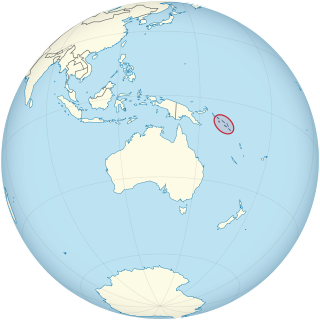
US Naval Base Solomons was a number of United States Navy bases in the Solomon Islands in the Pacific Ocean. Most were built by the US Navy Seabees, Naval Construction Battalions, during World War II as part of the Pacific War. In August 1942 the United States Armed Forces took the Guadalcanal in the Solomon, in the Battle of Guadalcanal. US Navy Seabees built a new base at Guadalcanal, Naval Base Guadalcanal and then on other islands in the Solomons.
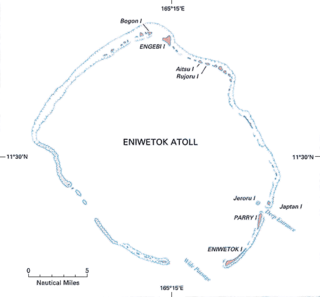
Naval Base Eniwetok was a major United States Navy base at the Eniwetok Atoll in the Marshall Islands in the western Pacific Ocean, just to west of the International Date Line, during World War II. The base was built to support the island hopping Pacific war efforts of the allied nations fighting the Empire of Japan. In 1944-5 it was one of the busiest naval bases in the world with over with over 488 ships.
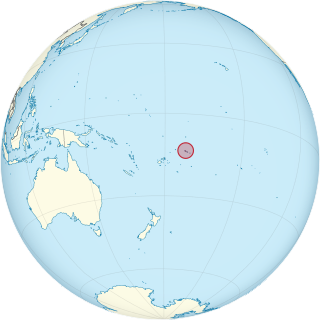
Naval Base Samoa, codename Operation Straw, was a number of United States Navy bases at American Samoa in the central Pacific Ocean. The bases were used during World War II to support the island hopping Pacific war efforts of the allied nations fighting the Empire of Japan.
